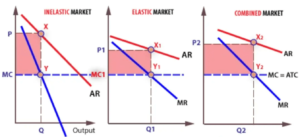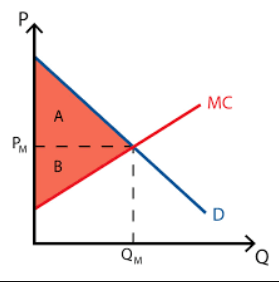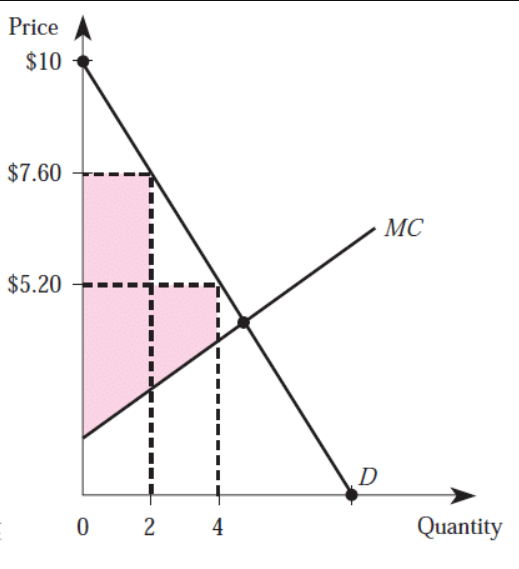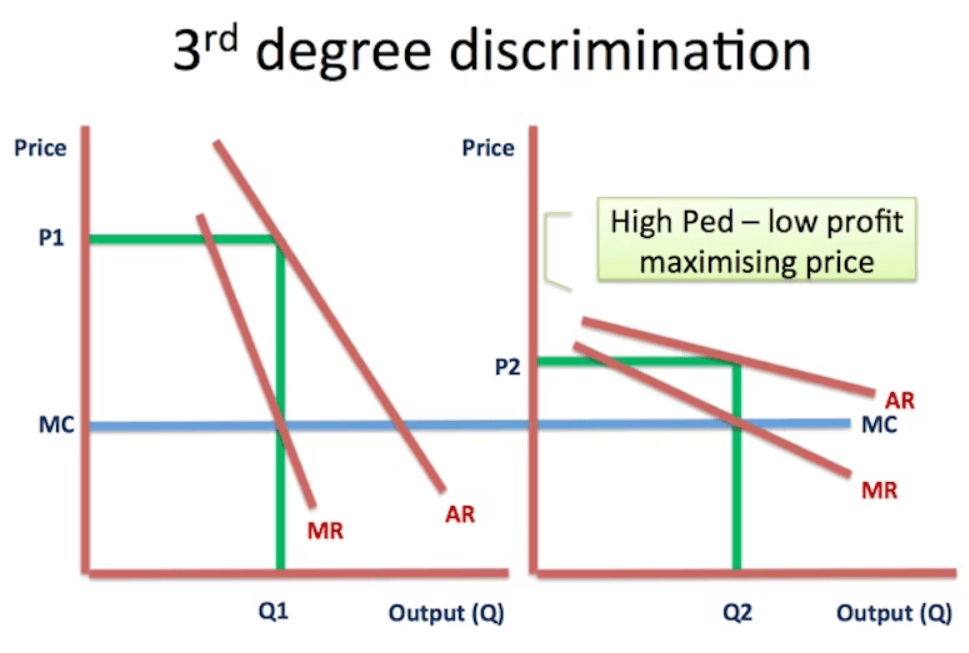Price discrimination is a pricing strategy employed by businesses to charge different prices to different groups of customers for the same product or service.
This strategy is rooted in the concept that not all customers are willing to pay the same price for a product, and businesses can maximize their profits by tailoring their pricing to various customer segments.
In this post, we will discuss price discrimination in detail, its types, conditions, benefits, criticisms, real-world examples, pricing techniques, and the role of government regulations.
See Also: Bain’s Limit Pricing Theory: A Strategic Approach to Market Control
Table of Contents
ToggleWhat is Price Discrimination | Different Definitions
Price discrimination is a pricing strategy where a business charges different prices for the same product or service to different customers, often based on their willingness to pay, location, or other factors.
We may also define price discrimination as the practice of selling the same product or service to different customers at varying price points, often based on factors like customer demographics, location, or purchasing behavior.

Types of Price Discrimination
-
First-Degree Price Discrimination (Personalized Pricing)
First-degree price discrimination, also known as personalized pricing, occurs when a business charges each customer the maximum price they are willing to pay.
This pricing strategy requires in-depth knowledge of individual customers’ preferences, allowing the seller to extract the highest possible surplus from each transaction.
Examples:
- Negotiated prices in business-to-business deals
- Dynamic pricing in e-commerce, where online retailers adjust prices based on a user’s browsing and purchasing history

-
Second-Degree Price Discrimination (Quantity Discounts)
Second-degree price discrimination involves offering different prices based on the quantity of goods or services purchased. Customers are incentivized to buy more by providing discounts for larger quantities.
Examples:
- Buy-one-get-one-free (BOGO) promotions
- Wholesale pricing, where the unit cost decreases with larger orders

-
Third-Degree Price Discrimination (Market Segmentation)
Third-degree price discrimination divides customers into distinct market segments and charges different prices to each group. These segments are typically based on factors such as age, location, income, or membership status.
Examples:
- Student discounts for movies or public transportation
- Senior citizen discounts at restaurants or retail stores
- Tiered pricing for software, with different feature sets for different user groups

Conditions for Price Discrimination
Price discrimination, a pricing strategy where a business charges different prices to different groups of customers for the same product or service, is a complex economic phenomenon. To effectively implement price discrimination, several conditions must be met.
-
Monopoly Market
Price discrimination is more commonly observed in markets where a single seller or a dominant firm holds significant market power. In a monopoly market, the absence of direct competitors allows the seller to set prices independently. Monopolistic control over the market is a fundamental condition for successful price discrimination.
In a competitive market with multiple sellers, consumers can easily switch to alternative suppliers if one tries to charge discriminatory prices. However, in a monopoly, customers have no choice but to accept the prices set by the monopolist, creating an environment conducive to price discrimination.
-
Market Power
Market power refers to the ability of a business to influence the market price of its product or service. Price discrimination is most effective when the seller possesses substantial market power. This power often arises from factors such as brand strength, control over resources, or proprietary technology.
A business with significant market power can manipulate prices without fear of competitive retaliation. This enables them to target different customer segments with varying prices, maximizing their overall revenue.
-
Segmentable Market
A segmentable market is one that can be divided into identifiable and distinct segments, each with its own price elasticity of demand. Price discrimination relies on the existence of these distinguishable segments.
If customers within a market segment exhibit similar price sensitivities and purchasing behaviors, it becomes feasible for a business to tailor pricing strategies to cater to each segment’s preferences.
-
Price Elasticity of Demand
Price elasticity of demand measures how responsive the quantity demanded of a good or service is to changes in its price. For price discrimination to work, different customer groups must display varying price elasticities.
Inelastic demand in one segment allows a business to charge higher prices without significantly reducing sales. Conversely, elastic demand in another segment requires lower prices to maintain sales levels. Understanding these elasticities is crucial for effective price discrimination.
-
No Resale
Price discrimination is most effective when goods or services cannot be easily resold from one customer segment to another at a lower price. Resale between segments would undermine the differential pricing strategy.
If customers could purchase a product at a lower price in one segment and resell it to another segment at a higher price, price discrimination would be less profitable for the business.
-
Information
To implement price discrimination successfully, the seller must have access to information that enables differentiation between customer groups. This information may include demographic data, purchase history, or behavioral insights.
Information about customers’ preferences, willingness to pay, and past purchasing behavior is essential for tailoring prices to specific segments. Without this data, it becomes challenging to identify and target distinct customer groups effectively.
Price discrimination is a pricing strategy that relies on specific market conditions to maximize a business’s revenue. While these conditions provide opportunities for differential pricing, they also pose challenges, including ethical considerations and regulatory scrutiny.
Understanding and navigating these conditions is essential for businesses seeking to implement price discrimination effectively while complying with relevant laws and regulations.
Benefits of Price Discrimination
Price discrimination, a pricing strategy where businesses charge different prices to different customer groups for the same product or service, often raises questions about fairness and ethics. However, from a business perspective, it offers several advantages that contribute to enhanced profitability and sustainability.
-
Maximizing Total Revenue
One of the primary benefits of price discrimination is the ability to maximize total revenue. By segmenting the market and charging higher prices to customers with lower price sensitivity (inelastic demand) and lower prices to those with higher sensitivity (elastic demand), businesses can capture a more extensive consumer base while optimizing revenue.
Explanation: Price discrimination allows businesses to charge the highest possible price to customers who are willing to pay more without losing price-sensitive customers. This results in a larger overall revenue compared to a uniform pricing strategy.
-
Enhanced Profit Margins
Price discrimination can lead to improved profit margins, especially when businesses identify high-value customer segments. By tailoring prices to match what different customer groups are willing to pay, companies can charge premium prices to those who value their products or services the most.
Explanation: High-profit margins enable businesses to allocate resources for further product development, marketing, and expansion, ultimately driving growth and competitiveness.
-
Better Resource Allocation
Price discrimination allows companies to allocate their resources more efficiently. By recognizing and catering to distinct customer segments, businesses can focus their efforts and investments on areas that generate the most substantial returns.
Explanation: With a clearer understanding of customer preferences and price sensitivities, companies can streamline their product offerings, marketing campaigns, and distribution channels to align with the needs of each segment, reducing wastage of resources.
-
Increased Market Share
Effective price discrimination can lead to an expanded market share. By accommodating different customer groups with varying price points, businesses can attract a more diverse customer base and establish a more comprehensive presence in the market.
Explanation: As businesses capture market share across multiple customer segments, they solidify their position and competitiveness, making it challenging for new entrants to gain a foothold.
-
Improved Customer Satisfaction
Price discrimination allows companies to offer tailored pricing options that align with customers’ preferences and budgets. This customization enhances customer satisfaction, as individuals feel they are getting a fair deal based on their perceived value.
Explanation: Satisfied customers are more likely to become repeat buyers and brand advocates, contributing to long-term business success.
-
Dynamic Pricing Flexibility
Price discrimination enables businesses to adopt dynamic pricing strategies. They can adjust prices in real time based on changes in demand, market conditions, or competitor pricing, ensuring they remain competitive and responsive to market dynamics.
Explanation: Dynamic pricing flexibility allows businesses to adapt quickly to shifts in consumer behavior, providing a competitive advantage in fast-paced markets.
-
Encouraging Product Adoption
Lower prices offered through price discrimination can incentivize new customer segments to try a product or service. This can be particularly beneficial for introducing products with a higher perceived value to a broader audience.
Explanation: Lower introductory prices can encourage customers to experience the product, potentially leading to long-term loyalty and higher lifetime value.
-
Regulatory Compliance
While it may not be a direct benefit, businesses that implement ethical and legal price discrimination practices are more likely to stay compliant with regulatory requirements, reducing the risk of legal actions and associated costs.
Explanation: Adhering to pricing laws and regulations ensures that businesses avoid penalties and maintain a positive reputation in the market.
Price discrimination, when executed thoughtfully and ethically, offers numerous benefits to businesses. While it may raise concerns about fairness, it provides companies with the flexibility to optimize their revenue, profit margins, and resource allocation.
To fully leverage these advantages, businesses must invest in market research, data analysis, and pricing strategies that align with their objectives and customer segments.
Controversies and Criticisms on Price Discrimination
Price discrimination, a pricing strategy where businesses charge different prices to various customer groups for the same product or service, is not without its share of controversies and criticisms.
While it offers advantages for companies, including maximizing profits and expanding market share, it also raises ethical, legal, and consumer fairness concerns.
-
Ethical Concerns
Explanation: Critics argue that price discrimination can be ethically questionable. Charging different prices to different customers for the same product or service may be seen as unfair or discriminatory. It may give the impression that businesses are taking advantage of certain customer groups based on their willingness to pay.
Impact: Ethical concerns can harm a company’s reputation and lead to negative consumer sentiment. Customers who perceive price discrimination as unfair may choose to boycott a business or seek alternatives.
-
Perceived Unfairness
Explanation: Price discrimination can create a sense of unfairness among customers, especially when they discover that others are paying less for the same product or service. This perceived unfairness can lead to frustration and dissatisfaction.
Impact: Customers who feel unfairly treated may share their negative experiences on social media, review platforms, or through word-of-mouth, potentially damaging a company’s reputation and eroding customer trust.
-
Complexity
Explanation: Implementing price discrimination can be complex, requiring businesses to segment their customer base effectively and set different prices. Managing various pricing tiers, discounts, and promotions may result in administrative challenges.
Impact: Complexity can lead to errors, confusion, and increased operational costs. Businesses must invest in systems and resources to manage price discrimination effectively.
-
Legal Challenges
Explanation: Price discrimination must comply with antitrust and competition laws. Businesses that engage in unfair or anticompetitive pricing practices may face legal consequences, including fines and lawsuits.
Impact: Legal challenges can result in financial penalties and damage to a company’s reputation. Businesses must carefully navigate legal boundaries when implementing price discrimination.
-
Consumer Backlash
Explanation: When customers perceive price discrimination as unfair or discriminatory, they may express their displeasure through organized protests, consumer advocacy groups, or petitions.
Impact: Consumer backlash can harm a company’s image and disrupt its operations. Negative publicity may lead to lost sales and long-term damage to a brand’s reputation.
-
Price Discrimination Arbitrage
Explanation: Price discrimination can open opportunities for customers to exploit price differences. Some customers may engage in arbitrage by purchasing products or services at lower prices in one market and reselling them in another at a higher price.
Impact: Arbitrage can disrupt a company’s pricing strategy and reduce its ability to capture value from different customer segments.
-
Customer Loyalty Challenges
Explanation: Price discrimination can strain customer loyalty, particularly when loyal customers discover that newcomers receive better deals or discounts.
Impact: Loyal customers may feel undervalued and may consider switching to competitors offering more equitable pricing.
-
Privacy Concerns
Explanation: To implement price discrimination effectively, businesses often collect extensive customer data, including purchasing history and preferences. This raises privacy concerns, especially when data breaches occur.
Impact: Privacy breaches can result in reputational damage, legal repercussions, and loss of customer trust.
Price discrimination offers advantages to businesses, it is not without its share of controversies and criticisms. These concerns revolve around ethical considerations, perceived unfairness, legal challenges, operational complexities, and potential backlash from customers and advocacy groups.
To navigate these issues, businesses must carefully evaluate the ethical implications of their pricing strategies, ensure compliance with legal requirements, and maintain transparency and fairness in their customer relationships.
Examples of Price Discrimination
-
Airlines
Airlines commonly employ price discrimination by offering various ticket classes, each with different prices and conditions. Business travelers might pay more for flexible tickets, while leisure travelers opt for cheaper, non-refundable fares.
-
Pharmaceuticals
Pharmaceutical companies often charge different prices for the same medications in different countries, based on the local market’s ability to pay.
-
Entertainment
Movie theaters offer discounts to students and seniors, while theme parks have tiered pricing based on age and height.
-
Education
Colleges and universities frequently charge different tuition rates for in-state and out-of-state students.
Pricing Strategies and Techniques in Price Discrimination
Price discrimination, a pricing strategy where businesses charge different prices to different customer groups for the same product or service, relies on a range of pricing strategies and techniques to maximize profits and cater to diverse consumer segments.
-
Market Segmentation
Businesses begin their price discrimination journey by segmenting the market into distinct groups based on various factors such as demographics, purchasing behavior, geography, or willingness to pay. This segmentation forms the foundation for tailoring prices to different customer segments.
Airlines often employ market segmentation by offering lower prices to budget-conscious travelers booking well in advance and premium fares to last-minute business travelers.
-
Price Discrimination by Time
Timing plays a crucial role in price discrimination. Businesses can offer discounts during off-peak periods, incentivize early bookings, or charge premium prices for urgent or last-minute purchases.
Movie theaters often provide matinee discounts for daytime screenings, encouraging price-sensitive customers to attend during non-peak hours.
-
Product Versioning
This strategy involves offering multiple versions or variations of a product or service, each with different features, at varying price points. Customers can choose the version that best aligns with their preferences and budget.
Software companies commonly employ product versioning by offering basic, pro, and premium versions of their software, appealing to different user needs and budgets.
-
Geographic Price Discrimination
Geographic pricing involves setting different prices for customers in different locations or regions. Factors like local demand, competition, and cost of delivery influence these price differentials.
Online retailers may adjust product prices based on the customer’s shipping address, taking into account shipping costs and local market conditions.
-
Segmented Discounts
Offering discounts based on specific criteria, such as age, profession, or membership in a particular group or organization, allows businesses to cater to specific customer segments.
Many businesses, including software providers, extend educational discounts to students and faculty members, acknowledging their unique pricing needs.
-
Dynamic Pricing
Dynamic pricing, also known as surge pricing, involves adjusting prices in real-time based on demand, supply, and other external factors. Prices can change frequently to optimize revenue.
Ride-sharing apps like Uber and Lyft use dynamic pricing during peak hours or high-demand events, with prices surging to balance supply and demand.
-
Bundling and Unbundling
Bundling combines multiple products or services into a single package, offering it at a lower price than the sum of individual components. Unbundling, conversely, separates products or services that were previously bundled.
Cable and streaming services often employ bundling strategies, while streaming platforms may offer individual subscriptions to unbundle content.
-
Personalized Pricing
Personalized pricing tailors offers based on individual customer data, such as past purchase history,
E-commerce websites frequently use personalized pricing by displaying different prices to different users based on their browsing history and behavior.
-
Coupon and Promo Codes
Providing coupons or promo codes allows businesses to offer discounts to specific customers or groups, providing an incentive for purchases.
Retailers distribute coupon codes to loyal customers or during marketing campaigns to stimulate sales.
-
Quantity Discounts
Encouraging customers to buy in larger quantities by offering bulk discounts can help increase overall sales volume.
Wholesale suppliers often provide tiered pricing, rewarding customers with lower per-unit prices for larger orders.
-
Opaque Pricing
Opaque pricing hides specific price details until customers commit to a purchase. This can create a sense of urgency and prevent price-sensitive customers from abandoning their carts.
Travel booking websites employ opaque pricing by revealing hotel or flight details only after the booking is confirmed.
-
Peak Load Pricing
This strategy involves charging higher prices during periods of peak demand when resources are limited.
Electricity providers may implement peak load pricing to manage demand during high-consumption hours, encouraging consumers to shift usage to off-peak times.
-
Membership and Loyalty Programs
Offering exclusive benefits, discounts, or pricing tiers to members or loyal customers can foster customer retention and encourage repeat business.
Retailers, airlines, and streaming platforms often introduce loyalty programs that reward frequent customers with discounted prices or exclusive access.
-
Loss Leader Pricing
A loss leader is a product offered at a steep discount or even a loss to attract customers to the store or platform, with the expectation that they will make additional full-priced purchases.
Grocery stores frequently use loss leader pricing by discounting popular items to draw shoppers into the store.
-
Version Updates and Upgrades
Software companies offer periodic updates or upgrades, typically at a cost, to entice users to adopt newer versions with enhanced features and functionalities.
Operating systems, productivity software, and video games leverage version updates and upgrades to generate additional revenue.
Price discrimination encompasses a wide array of strategies and techniques that businesses employ to tailor their pricing strategies to different customer segments and maximize profitability. By understanding these strategies and their applications, businesses can make informed pricing decisions that align with their objectives and customer dynamics. Whether through market segmentation, personalized pricing, or dynamic pricing, price discrimination allows businesses to remain competitive and adaptive in today’s diverse and dynamic markets.
Government Regulations and Antitrust Laws for Price Discrimination
Price discrimination, a common pricing strategy employed by businesses to maximize profits, must operate within the bounds of government regulations and antitrust laws.
Government regulations and antitrust laws aim to ensure fair competition, prevent monopolistic practices, and protect consumers from unfair pricing tactics.
These regulations and laws apply to various industries, including technology, healthcare, and retail, to maintain a level playing field.
-
The Sherman Antitrust Act
Enacted in 1890, the Sherman Antitrust Act is a cornerstone of antitrust legislation. It prohibits contracts, combinations, or conspiracies that restrain trade or monopolize markets.
The act has been instrumental in challenging anticompetitive behavior and monopolies in numerous legal cases.
-
The Clayton Act
The Clayton Act, passed in 1914, addresses anticompetitive mergers and acquisitions, price discrimination, and exclusive dealing agreements.
It provides legal mechanisms to prevent anticompetitive practices and protect consumers’ interests.
-
The Federal Trade Commission Act
The Federal Trade Commission (FTC) Act created the FTC in 1914 to enforce antitrust laws and protect consumers from deceptive trade practices.
The FTC investigates and takes action against companies engaging in unfair competition and deceptive advertising.
-
Price Discrimination and the Robinson-Patman Act
The Robinson-Patman Act, an amendment to the Clayton Act, addresses price discrimination concerns. It prohibits unfair price distinctions that harm competition.
The act ensures that businesses cannot unfairly favor certain customers or retailers with discriminatory pricing.
-
The Role of Regulatory Agencies
Regulatory agencies like the FTC and the Department of Justice (DOJ) play a pivotal role in enforcing antitrust laws and scrutinizing price discrimination cases. These agencies investigate potential violations, impose fines, and advocate for fair competition.
-
The Elements of Price Discrimination under Antitrust Laws
To establish a price discrimination case, certain elements, such as direct competition and harm to competition, must be present.
Legal cases often revolve around proving these elements in the context of alleged price discrimination.
-
Defenses Against Price Discrimination Allegations
Businesses facing price discrimination allegations may employ various defenses, including meeting the requirements of cost justification or demonstrating different market conditions. These defenses are crucial in defending against antitrust claims.
-
Recent Price Discrimination
Recent legal cases involving price discrimination highlight the ongoing relevance of antitrust laws and their application in contemporary markets.
High-profile cases provide insights into how price discrimination issues are addressed in the digital age.
-
The Future of Price Discrimination Regulation
As markets evolve, the landscape of price discrimination and antitrust laws continues to adapt to emerging challenges, such as e-commerce and data-driven pricing.
Policymakers and regulatory bodies constantly assess and update regulations to address new dynamics in the business world.
-
Balancing Profit Maximization and Fair Competition
Government regulations and antitrust laws serve as a critical counterbalance to unchecked price discrimination practices, ensuring that businesses prioritize fair competition while pursuing profit maximization.
By adhering to these regulations, companies can navigate the complex landscape of price discrimination without running afoul of the law, fostering a competitive and equitable marketplace.
Government regulations and antitrust laws are indispensable in maintaining fair competition in markets where price discrimination strategies are prevalent.
As businesses continue to innovate and adapt their pricing tactics, regulatory bodies and legal frameworks evolve to safeguard consumer interests and uphold the principles of a competitive marketplace.
Understanding the intricacies of these regulations is essential for businesses to thrive while complying with the law and contributing to a level playing field for all market participants.
Price Discrimination in Economics | Types | Benefits | Criticisms | Examples | Strategies | PDF Free Download |
Conclusion
Price discrimination is a complex pricing strategy used by businesses to optimize profits and allocate resources efficiently. While it has clear advantages, such as increased profitability and enhanced market efficiency, it also faces ethical concerns and regulatory scrutiny.
Understanding the various types, conditions, benefits, criticisms, and real-world examples of price discrimination is essential for both businesses and policymakers as they navigate the complex landscape of pricing in modern economies.
See Also: What is Limit Pricing | Objectives | How It Works | Factors | Criticism










